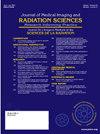Management of Continuous Glucose Monitors and Insulin Pumps during Radiation Therapy
IF 1.3
Q3 RADIOLOGY, NUCLEAR MEDICINE & MEDICAL IMAGING
Journal of Medical Imaging and Radiation Sciences
Pub Date : 2025-05-01
DOI:10.1016/j.jmir.2025.101944
引用次数: 0
Abstract
Purpose/Aim
Insulin Pumps (IPs) or Continuous Glucose Monitors (CGMs) may be damaged if they are worn during diagnostic imaging tests or during radiation therapy treatments due to exposure of electromagnetic fields as per manufacturers warnings. This means that blood sugar readings may not be accurate. In order to comply with the manufacturers recommendations, the sensor or transmitter attached to the patient needs to be removed before CT simulation and left off for all radiation treatments. Within our institution, there has not previously been a process in place to manage CGMs or IPs prior to radiation therapy treatments.
Methods/Process
An interprofessional working group was initiated in order to review the latest evidence on the subject and to determine a plan for implementing a process to align with manufacturers recommendations. There is a significant cost associated with removing the sensor or transmitter for patients without drug coverage, which also needed to be considered in the context of the removal recommendations. The working group collaborated with the Diabetes Education Program (DEP) at our institution to setup a pathway whereby Radiation Oncologists (ROs) could enter referrals to the DEP for Type 2 diabetic patients as needed for the purposes of ensuring timely support for radiation patients requiring alternate monitoring methods (finger stick testing). It was decided that the initial conversation with applicable patients should occur at the radiation consult appointment and the discussion would be facilitated by the RO and/or nurse. In order to help facilitate this conversation and to ensure patients were made aware of the risks associated with leaving the device(s) on, a patient education handout was developed by the working group and subsequently reviewed by our institution's Cancer Centre Patient Education Advisory Group which includes patient advisors. Checklists were built within the radiation oncology electronic record to document the presence of CGM and IP devices at CT Sim as well as to follow up at Day 1 treatment appointments. The radiation therapists at CT Sim confirm the patient has removed the devices, educating about risks if they decline to remove for CT Simulation and/or radiation treatments. Documentation to occur by radiation therapists in order to capture details of the conversations and to reinforce safety elements and ability to provide the patient education handout as needed.
Results or Benefits/Challenges
Implementation has streamlined expectations for our patients and reduced questions or concerns from the team as they have been addressed. There have been a few scenarios post implementation, where patients are unaware at the time of CT Simulation about the recommendation to remove their devices. In addition, there have been no referrals by ROs to the DEP after a 5-month period since implementation. Follow up is occurring to ensure adequate supports are in place for this patient population.
Conclusions/Impact
The ability to readily pull data from the electronic radiation record will allow for tracking of volumes and to be able to determine the compliance with the recommendations for removal. There is also a plan to seek more formal feedback from patients directly impacted to ensure we are meeting their needs and to determine any opportunities for improvement.
放射治疗期间连续血糖监测和胰岛素泵的管理
目的/目的胰岛素泵(IPs)或连续血糖监测仪(cgm)如果在诊断成像测试或放射治疗期间佩戴,根据制造商的警告,由于暴露在电磁场中,可能会损坏。这意味着血糖读数可能不准确。为了符合制造商的建议,在CT模拟之前,患者身上的传感器或发射器需要被移除,所有放射治疗都需要停止。在我们的机构内,以前没有适当的流程来管理放射治疗前的cgm或IPs。成立了一个跨专业工作组,以审查有关该主题的最新证据,并确定实施流程的计划,以与制造商的建议保持一致。对于没有药物覆盖的患者,移除传感器或变送器的成本很高,这也需要在移除建议的背景下考虑。工作组与我们机构的糖尿病教育计划(DEP)合作,建立了一条途径,使放射肿瘤学家(ROs)可以根据需要将2型糖尿病患者转介到DEP,以确保对需要替代监测方法(指棒测试)的放射患者提供及时支持。我们决定在放射会诊预约时与病人进行初步对话,并由主任主任和/或护士协助讨论。为了促进这一对话,并确保患者意识到离开设备的风险,工作组制定了一份患者教育讲义,随后由我们机构的癌症中心患者教育咨询小组审查,其中包括患者顾问。在放射肿瘤学电子记录中建立了检查清单,以记录CT Sim中CGM和IP设备的存在,并在第一天的治疗预约中进行随访。CT模拟中心的放射治疗师确认患者已经移除设备,并告知他们如果拒绝移除设备进行CT模拟和/或放射治疗的风险。放射治疗师要记录下谈话的细节,加强安全因素,并根据需要提供病人教育资料。结果或益处/挑战实施简化了对患者的期望,并减少了团队在解决问题时提出的问题或担忧。在实施后的一些情况下,患者在CT模拟时不知道建议移除他们的设备。此外,自实施以来的5个月期间内,没有任何地方注册主任将个案转介至环境发展处。正在进行随访,以确保为这一患者群体提供足够的支持。结论/影响从电子辐射记录中提取数据的能力将允许对体积进行跟踪,并能够确定是否符合移除建议。我们还计划从直接受到影响的患者那里寻求更正式的反馈,以确保我们满足他们的需求,并确定任何改进的机会。
本文章由计算机程序翻译,如有差异,请以英文原文为准。
求助全文
约1分钟内获得全文
求助全文
来源期刊

Journal of Medical Imaging and Radiation Sciences
RADIOLOGY, NUCLEAR MEDICINE & MEDICAL IMAGING-
CiteScore
2.30
自引率
11.10%
发文量
231
审稿时长
53 days
期刊介绍:
Journal of Medical Imaging and Radiation Sciences is the official peer-reviewed journal of the Canadian Association of Medical Radiation Technologists. This journal is published four times a year and is circulated to approximately 11,000 medical radiation technologists, libraries and radiology departments throughout Canada, the United States and overseas. The Journal publishes articles on recent research, new technology and techniques, professional practices, technologists viewpoints as well as relevant book reviews.
 求助内容:
求助内容: 应助结果提醒方式:
应助结果提醒方式:


